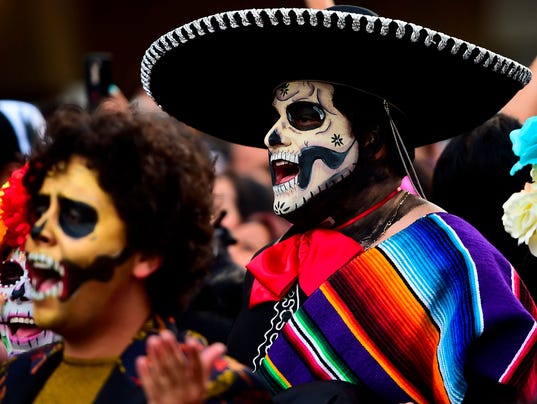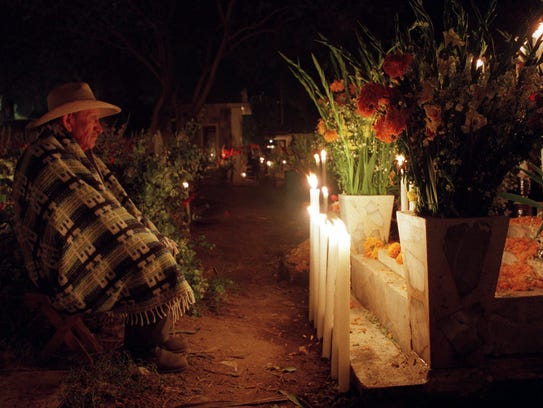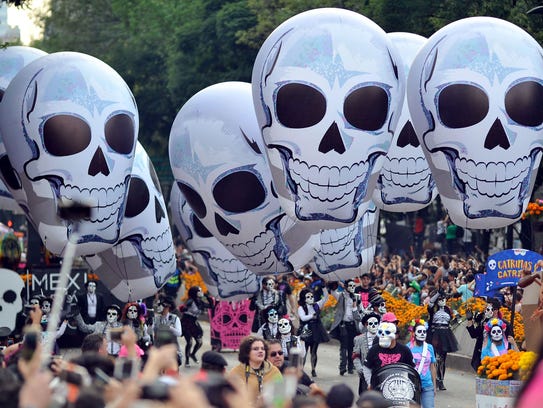
Although dwindling in number, there are still many Americans who have never heard of Día de los Muertos (or Day of the Dead). Those who have heard of it, but don't really know much about it, sometimes refer to it as "Mexican Halloween."
While Halloween and Day of the Dead do share common roots, they are totally different holidays.
One major distinction is that Halloween is only one night, whereas the Day of the Dead is actually a three-day event that is just getting starting on Oct. 31. Halloween is short for All Hallows Eve, the night before All Saints' Day, a Catholic celebration commemorating saints and martyrs. All Souls Day, honoring all the Christian departed, follows on Nov. 2. Taken together, the three events are sometimes referred to as Allhallowtide and all of them are part of the Day of the Dead celebrations. 

Magdaleno Melendez, 78, visits the grave of his father during Day of the Dead celebrations in San Gregorio Atlapulco, before sunrise Nov. 2, 2000. (Photo: Marco Ugarte, Associated Press)
Halloween's connection to the afterlife has largely been stripped from the holiday. The aspects of the holiday that do touch on death — such as the prevalence of ghosts, ghouls and other spirits in costumes and decorations — tend to focus on our fear of mortality and the spookiness of the unknown.
The Day of the Dead, on the other hand, focuses squarely on death (it's in the name after all). But rather than treating it as something dark and frightening, the Day of the Dead is largely about laughing in the face of death, as represented by the ubiquitous skulls and skeletons known as calaveras and Catrinas, which are often depicted dancing or playing music. And though it is about remembering lost loved ones, the holiday is more a time to celebrate their memories than to mourn their loss.
"The Day of the Dead is a day of connection, remembrance and love — for and with — those who have died (‘the ancestors’)," said Kristin Norget, author of Days of Death, Days of Life: Ritual in the Popular Culture of Oaxaca. "Halloween is completely lacking this important dimension."
The Day of the Dead is believed to be a time when the spirits of dead ancestors and relatives return to the world of the living for a visit.
"Halloween has nothing to do with ancestors," said Stanley Brandes, a professor of anthropology at the University of California, Berkeley. "Day of the Dead has everything to do with deceased relatives. That's the basis of it." 

People take part in the Day of the Dead parade in Mexico City on Oct. 28, 2017. (Photo: Victor Cruz, AFP/Getty Images)
There is wide variation in the way the Day of the Dead is celebrated across Mexico and the holiday is constantly evolving. For example, Halloween costumes are becoming more common in parts of Mexico on Oct. 31, and large parades have become part of the holiday, especially in Mexico City.
From Oct. 31 to Nov 2. people across Mexico clean relatives' graves and decorate them with bright flowers (typically marigolds) candles and things the deceased loved in life (food, coffee, alcohol and tobacco are common). They stay overnight in the cemetery and hold a vigil at their loved one's grave

Candles illuminate grave sites at the San Gregorio cemetery during the Dia de los Muertos or Day of the Dead holiday on the outskirts of Mexico City, Nov. 1, 2011. (Photo: Marco Ugarte, AP)
It is also very common, especially for the people unable to make an overnight gravesite visit, to build an elaborately decorated altar in their home, known as an ofrendas, that incorporates reminders of the dead person, including photographs and the things the person loved.
"Come the end of October, a multitude of foreign visitors descends upon Mexico to witness colorful — some would say carnivalesque — ritual performances and artistic displays. Decorated breads, paper cutouts, and plastic toys, most of them playing humorously on the death theme are evident everywhere," Brandes wrote in an article for the American Folklore Society. "Sculpted sugar candies in the form of skulls, skeletons, and caskets suggest an almost irreverent, macabre confrontation with mortality."
All Saints Day and All Soul's Day are observed across the Catholic world, as well as by some Protestant faiths. Many of the elements that make up the Day of the Dead, including the gravesite vigils and sweets are not unique to Mexico. But Mexico stands out for the rich, joyful flavor of the celebration.
"What seems to me unique to Mexico are three features of the celebration: first, the name Day of the Dead; second, the abundance of variety and whimsical sweet breads and candies; and third, the humor and gaiety that pervade the holiday," wrote Brandes.

A traditional candy made of sugar in a skull shape in the village of Yuriria, Mexico, Oct. 28, 2017. (Photo: Mario Armas, epa)
In Of Corpse: Death and Humor in Folklore and Popular Culture, Kristin Congdon said part of that humor comes from to a reversal of social norms that is tied to Day of the Dead.
"While in some company it might be rude or inappropriate to flaunt or laugh at death, or to conspire with the dead, an aesthetic reversal, especially in a ritual space, can make the unacceptable acceptable," Congdon said. "Additionally, those who might be set aside or forgotten, like the dead, are remade, enjoyed, and visible."
In North American culture, particularly Anglo-Protestant U.S. culture, death is a subject people largely try to bury. "Death has been something to avoid," Norget said. "It is ugly, associated with negative emotions; it's something to be feared."
Norget also said, generally speaking, U.S. culture tries to shield people from the reality of death and move "the ritualization of death from the home" to funeral homes and hospitals.
The contrast in the attitudes toward death in Mexico in the United States was summed up in a famous passage about the Day of the Dead by Mexican author, and Nobel Laureate, Octavio Paz in his 1950 work, The Labyrinth of Solitude.
The word death is not pronounced in New York, in Paris, in London, because it burns the lips. The Mexican, in contrast, is familiar with death, jokes about it, caresses it, sleeps with it, celebrates it; it is one of his favorite toys and his most steadfast love.
It is natural, even desirable, to die, and the sooner the better. We kill because life —our own or another's — is of no value. Life and death are inseparable, and when the former lacks meaning, the latter becomes equally meaningless. Mexican death is the mirror of Mexican life.
Brandes believes the idea that Mexicans have a different attitude toward death is greatly overstated, however.
"I see the same reaction that people have to the death of a relative in Mexico as in the United States," Brandes said. 'There’s the same kind of grief and dismay and the horrible sense of loss."
But, Brandes does see a difference between a funeral in Mexico, "with its terrible grief and mourning" and the Day of the Dead with "the sort of joyous flavor you get with music and humor."
Day of the Dead celebrations in Mexico are growing and they are becoming bigger in the U.S. as well. Brandes believes much of its popularity is due to its promotion by the Mexican government. In part, the promotion is driven by a desire to increase tourism, but it is also powered by a need to establish a unique, Mexican identity Brandes said.
"For Mexicans, foreigners, and peoples of Mexican descent, the holiday has come to symbolize Mexico and Mexicaness," Brandes said. "It is a key symbol of national identity."
"As death has become less frequent, and people are living longer, the celebration of death has gotten bigger and bigger, and more expensive, and it's due to a lot to hype," he said.

No comments:
Post a Comment